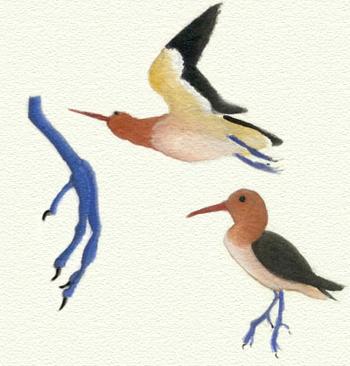Dozens of fossils of a "tablan"-like creature that some believe constitutes the missing link in the evolution of birds have been discovered in northwest China.
Avi Blizovsky

Dozens of fossils of a "tablan"-like creature that some believe constitutes the missing link in the evolution of birds have been discovered in northwest China.
Remains of 40 of the almost modern amphibious birds were so well preserved that some of them even had their feathers preserved. They were found in Gansu province, researchers report in today's issue of the journal Science. Previously, only a single leg of the creature known as Gansus yumenensis had been found.
"Gensus is the missing link in the evolution of birds". says Matt Lamanna of the Carnegie Museum of Natural History in Pittsburgh.
Most of the relatives of the birds from the time of the dinosaurs were members of groups that became extinct and had no modern descendants left, but Gensus led to modern birds, and therefore they are the link between the primitive birds and the ones we see today," said Lemane, co-head of the research team to the news agencies.
The chicken was the size of a pigeon, but it was more like a grebe or a diving duck, he explains, adding that one of the fossils even had a piece of skin left between its toes, which shows that this bird had a living membrane.
"We are much luckier than we expected in finding these fossils," said Ai-Lu Yu of the Chinese Academy of Geological Sciences. "A world that was lost for over a hundred million years has been revealed to us." said. "Previously we had a gap between the ancient birds and the birds of our day and Gensus is exactly suitable to fill that gap," added Dr. Gerald Harris of Dixie College in Utah.
"Gensus is the oldest example of near-modern birds that branched off the family tree that began with the proto-bird Archaeopteryx," said Peter Dodson of the University of Pennsylvania, who co-authored the paper with Lamanna, Yu and others.
The remains date back 110 million years, making them the oldest in the Ornithora group, which includes modern birds and their extinct relatives. Previously, the oldest known fossil in this group was 99 million years old.
The fact that Gensus was a sea fowl suggests that modern birds evolved from creatures that originated in the marine environment, the researchers say. "Our new specimens are very well preserved, and some of them even bear remnants of feathers," Lamana said. "Because these fossils are in such good condition, we were able to reproduce their external appearance and their proximity with a high degree of accuracy. They provided new insight into the evolutionary transformation of meat-eating dinosaurs into birds as we know them today. The remains were found at the bottom of an ancient lake near the city of Changma. Researchers had to split open slabs of mudstone to find them. It was like turning pages in a book, he told Amana.
"We went to Chamanga, and we thought we would find the remains of one or two creatures," he said, "instead we found dozens, including some whose skeletons and some soft tissues were in good condition. We succeeded beyond our wildest dreams."
<For news on Yahoo's news site
A 47-million-year-old fossil may be the common ancestor of today's humans and apes
